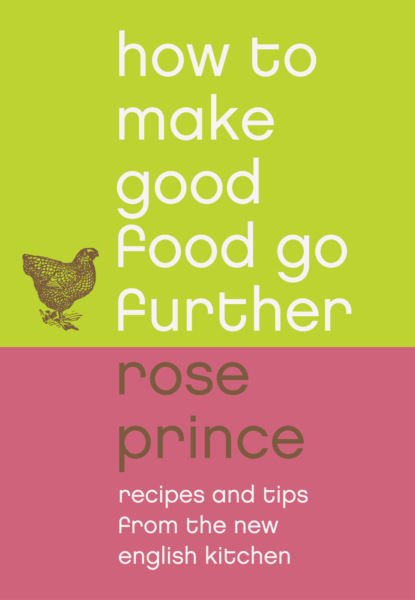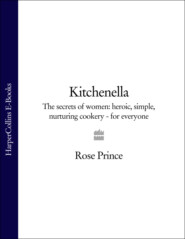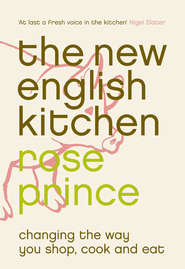По всем вопросам обращайтесь на: info@litportal.ru
(©) 2003-2024.
✖
How To Make Good Food Go Further: Recipes and Tips from The New English Kitchen
Настройки чтения
Размер шрифта
Высота строк
Поля
Making bread at home
I make bread twice a week in a food mixer with an attached dough hook. Each batch of two loaves takes ten minutes to mix and knead. Two hours later I shape it, and about an hour later the bread is baked. There is very little physical work – bread needs your presence more than anything else. People who go out to work will find breadmaking machines useful. Alternatively you can make the dough in a mixer, put it in the fridge for the day and shape and bake it when you get home.
Hands versus machine
Making bread by hand is a real pleasure, but you will need to set aside a good 15 minutes to knead the dough. Food mixers make smooth, elastic dough. I have a KitchenAid but have also used a Kenwood mixer in the past. Use mixers fitted with a dough hook on a low setting.
Busy people swear by their bread machines. They can do the whole job for you, or be set to stop when the dough is ready so it can be shaped and cooked in a conventional oven. Beware of the manufacturer’s recipe books. Some of them include recipes that are simply aping the factory process, with too much yeast and milk powder so the bread will be big and soft. Use traditional recipes instead, using the quantities given in the manufacturer’s recipe book as a guide, and you will be very pleased with what a bread machine can do.
*kitchen note*
Look for used Kenwood mixers in local papers and car boot sales – a heavy old one with a good motor will go on for years.
The cost of bread
At the time of writing, I buy flour in bulk (8kg bags from www.stoatesflour.co.uk (http://www.stoatesflour.co.uk)) and it costs me approximately 58 pence to make an 800g loaf, plus negligible costs for yeast and oven power. A loose calculation based on baking four good-quality loaves a week means that I spend £90.48 as opposed to £226 on lower grade bread, or approximately £624 on high grade artisan bread. A huge saving, leaving money for treats.
Buying flour
I used to be hopeless at making scones. When I worked at the bakery, we threw away more scones than we sold because they were always dry, weighty and crumbly. Twenty years later I nibbled a sample scone from a stall at a farmers’ market. Light and chewy, without a hint of dryness, this was the scone we were never able to make in the bakery. The stall-holder, slightly taken aback by the passionate interrogation I inflicted on her, casually remarked, ‘Oh, it’s the flour.’ She bought her flour from Cann Mills, a local water mill in Dorset. She did not know why it was so good, it just was.
I wanted to know more, so I visited the mill. The miller, Michael Stoate, took up the story of good wheat flour, the type most commonly used for making bread, scones and cakes. The modern milling industry rolls the grain to remove the bran, taking out the wheatgerm and the flour’s natural oil as it does so. This also removes a vital source of vitamins, which means that they have to be added back to the flour artificially. The wheatgerm oil is very valuable to the pharmaceutical industry, which puts it into creams to go on the outside of our bodies – oh, the irony of it. What’s more, commercial bakers need not mention that it is missing from the flour. About 70 per cent of the bread bought in the UK is made from roller-milled white flour. That is a scandalous amount of missing wheatgerm from what most of us presume is a wholefood.
Stoneground flour, whether white or brown, still contains the wheatgerm – the white flour is simply sifted to remove the bran. Michael Stoate uses millstones to grind all his flour, including the white flour that was used in those scones, with their delightful texture. Traditionally milled stoneground flour can be bought direct from mills, and in some cases delivered to your home. Look also in specialist independent food shops, farm shops or farmers’ markets, and on the internet. Some supermarkets stock British flour from traditional mills, but do check the label carefully.
Store flour in a sealed bin to keep out pests, or buy it in smaller bulk bags of about 5 kilos that can be sealed between use.
Bread baked in tins or shaped into high rounds needs strong flour, made from ‘hard’ wheat species. These contain a greater amount of glutenin and gliadin, essential for the bread to rise well and form a nice, elastic crumb. In the past, hard wheat was grown mainly in North America for the British bread industry, but with selective breeding it has been adapted over the last few decades to grow well in British conditions. Do not confuse strong flour with hard durum wheat flour, or semolina, which is used specifically for pasta making.
Soft wheat flour, sold as plain flour, is suitable for cake and pastry making and can also be used for soda bread and scones.
Other types of flour
While the gluten in wheat flour is vital for the standard bread recipe, a percentage of another type of cereal flour can be added for variety, such as rye, barley, buckwheat or oats. These cereals, however, contain little gluten, and yeast bread made with rye, barley or oat flour alone will be heavy, and does not keep well. Alternative types of flour, made from vegetables like chick peas or potato, are more useful in other forms of cookery. There are recipes using these flours.
A little bread science
The breadmaking process is easier to understand once you know a little piece of molecular chemistry. Yeast gives dough its oomph, but it needs gluten to do so. Live yeast makes bubbles of carbon dioxide in the soft, elastic dough. The legend of the first yeast goes that a cook left a piece of dough near a vat of beer and some of the wild yeasts from the ale got into the dough. The cook noticed the bubbles in the bread – the rest is history.
When water comes into contact with flour, it swells the proteins in it. Kneading the dough by hand or machine allows these proteins to blend, changing the molecular structure and forming the all-important gluten.
You must choose if you want to add fat to your bread. Fat improves bread’s keeping qualities and gives it a denser texture. It can, however, prevent the dough becoming soft and elastic if it is rubbed into the flour before the water is added, because this delays the essential formation of gluten. Gluten is to dough what steel frames are to skyscraper construction. Its strength allows large spaces of air to form and hold within the dough. The best way to get bread going quickly is to add fat after the water. I do this by oiling the bowl that holds the dough as it rises, then mixing it in before the bread is shaped.
It is fine to leave fat out of bread; it simply results in a lighter dough with large bubbles. If you make small quantities of bread frequently, or rolls, there is no real need to add fat.
Two things kill yeast: too much salt, and heat. Don’t be too free with salt – follow the amount specified in recipes until you get to the stage where experience teaches you how much to add. And don’t leave the dough to rise anywhere too hot, such as on a radiator or beside a fire. In fact, bread doesn’t have to be left in a warm place to rise at all, and will even rise perfectly happily – though slowly – in the fridge. The important thing is that it should be in a draught-free place.
How to knead bread by hand
Take the dough, which will still be sticky, out of the bowl and place it on a floured work surface. Use both hands to pull and stretch the bread, folding it back on itself, pulling and stretching again, giving it a quarter turn each time. Persevere for several minutes – 15 is best. The process helps the gluten develop, making the dough silky, soft and elastic. Be robust when kneading – you can be as aggressive as you want, since it will speed up the process.
Basic yeast bread
This recipe works well in a food mixer and can be used for the classic, rectangular tin loaf or for any other shape. Strong white flour, malted wheat, wholemeal or a mixture all work well.
Makes 2 small loaves
700g/1 ½lb flour
2 x 7g sachets of fast-action (easy-blend) yeast
1 heaped teaspoon fine salt or 2 teaspoons soft sea salt crystals
1 heaped teaspoon unrefined sugar
425ml/14fl oz water, at blood temperature
1 tablespoon vegetable or olive oil
Put the flour in a large bowl with the yeast, salt and sugar and stir until combined. Make a well in the centre and add the warm water, stirring all the time until the ingredients form a sticky dough. Continue to knead the bread – by hand (see above) for 15 minutes, or for 5 minutes on the slow setting of a food mixer fitted with a dough hook. If the dough is too sticky, add more flour; if it is too dry, work in a little water.
The dough will become smooth and elastic as the gluten forms. When you have finished kneading it, put it into an oiled bowl (if you are using the oil), cover with a cloth and leave in a warm, draught-free spot for 1 ½–2 hours, until doubled in size (or leave for longer at cool room temperature, or overnight in the fridge).
Knock the air out of the dough, kneading the oil into it. Prepare two 480g/1lb loaf tins by brushing all over the inside surface with a little oil. Divide the dough in half, shape each piece into a fat sausage and put into a tin or make 2 rounds and place each in the centre of a baking sheet. Scatter flour on top, cut a slash lengthways down the centre with a sharp knife and leave to rise again, uncovered, for 20–30 minutes. Preheat the oven to 230°C/450°F/Gas Mark 8.
Bake the loaves for 30–40 minutes. They are ready when they come easily out of the tin and sound hollow when tapped on the base with a finger.
*kitchen notes*
To improve the quality of the crust, put a roasting tin half filled with water in the oven as you preheat it and leave in during baking.
If bread goes wrong, it could be the weather. Ambience affects bread: on humid days the dough needs slightly less water; when the weather is dry, it will need more.
You can freeze bread at almost any stage of the preparation – before the dough has risen; after knocking it back, or after baking.
More adventures with dough
Once you are hooked on making bread at home, it is easy to adjust the recipe or substitute different flours and ingredients. I am not crazy about adding olives, Parmesan, sun-dried tomatoes or fried onions to bread – I’d rather eat those things another way – but working fresh herbs or aromatics into the dough does have a good effect. A few chopped rosemary leaves or sage make a nice savoury bread. Steeping some saffron threads in the warm liquid before you add it to the flour makes a beautiful saffron-scented loaf, delicious with dry-cured meats and fresh cheeses.
To make tea bread, set aside a piece of dough and roll it into a rectangle. Scatter over a little brown sugar and some chopped dried fruit (figs, raisins, prunes or apricots), then roll it up into a Swiss roll shape. Either brush it with beaten egg and bake whole, or cut it into slices to make Chelsea buns, lay these on a greased baking sheet, brush with egg and bake. Scatter some golden caster sugar on Chelsea buns when they come out of the oven.
Substituting milk for water in your dough will make a softer, sweeter tea bread.
Sourdough bread
Sourdough bread is a treat to buy from a specialist baker and can be eaten fresh or used in recipes. I admit I often beg mine from my sister and brother-in-law, Sam and Sam Clark. With apologies to the late M. Poîlaine, creator of the famous sourdough loaf, pain Poîlaine, and, honestly, no sibling conspiracy, I believe their experiments at their restaurant, Moro, have resulted in the absolute best there is. A recipe for it is given in Moro – The Cookbook (Ebury, 2001).
Slow fermentation of the yeast in bread makes a sour dough. You can make your own yeast, beginning with a combination of flour and fruit juice and ‘feeding’ the bacteria, but there are simpler methods for home kitchens. Leaving the dough to rise overnight in the fridge, rather than giving it a quick rise in a warm place, produces a more sour dough. You can also knead into it a piece of dough left over from breadmaking a few days earlier (keep it in the fridge, wrapped in cling film; it will sour as it matures). When you make your bread, use only half the yeast specified in the recipe and work the older dough into the new. Allow your dough to rise in the fridge either overnight or during the day. Once baked, the bread will have a full, ripe, savoury taste and the scent of toasted nuts. It will have a strong, tactile crumb, and larger bubbles even if you have used fat. There is no doubt at all that the inner crumb of sourdough keeps its elasticity longer. Nor will the flavour diminish as it ages: old sourdough bread will be as good eaten fresh as it is in your cooking.









